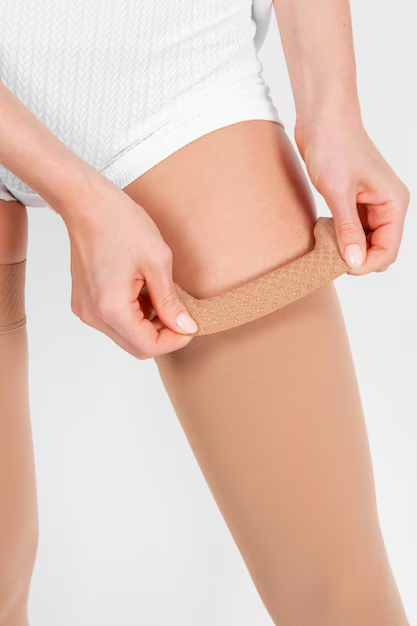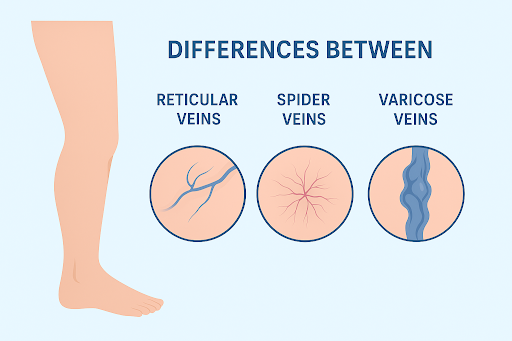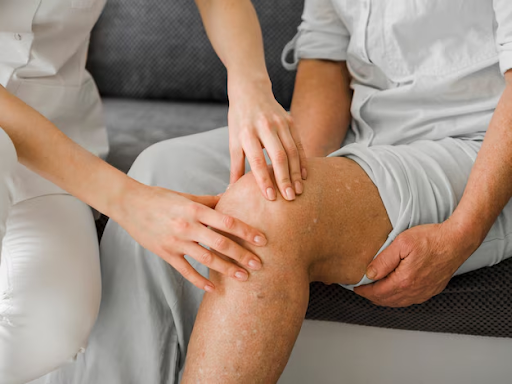If your work has you on your feet all day or experiencing poor circulation, you may have wondered if compression stockings are worth a try. The short answer? They just may be. Compression stockings can provide much-needed vein treatment support and relief, whether it is swelling, tired legs, or more severe vein-related problems.
But not all compression stockings are created equal, and knowing when to wear compression stockings and how to choose the right one can be a lifesaver, especially when managing issues that might require varicose vein treatment or consulting a spider vein specialist.
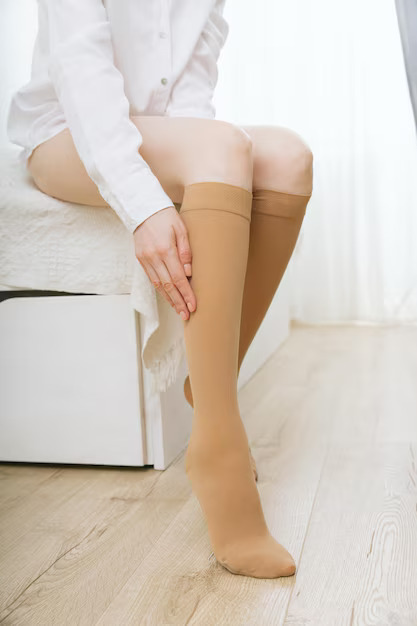
What Are Compression Stockings?
Compression stockings are specially designed clothing items that gently squeeze the legs using a snug, flexible fabric. In contrast to ordinary socks, compression stockings offer steady pressure, supporting your veins and enhancing blood flow. Whether on your feet all day, recovering from surgery, or managing a medical condition like varicose vein treatment, these stockings can be a game-changer for leg comfort and health.
For individuals who suffer from painful, fatigued legs after a day on the job or develop swelling because of poor circulation, compression stockings provide a pain-free vein treatment solution that can bring significant relief. Though they will not cure venous disease, they are critical in symptom management and improving quality of life.
How Compression Stockings Improve Blood Flow
Knowing how compression socks help veins starts with the fundamentals of your circulatory system. Your oxygenated blood gets pumped by your heart through the arteries to different parts of the body, including your legs. Once the nutrients and oxygen have been supplied, the blood must return through the veins to the heart.. But this return trip isn’t as simple, particularly in the legs.
Unlike arteries, veins don’t have the strong, muscular walls needed to push blood back upward. Instead, they rely on small one-way valves and the natural movement of your leg muscles, especially your calves, to propel the blood upward. When these valves are weakened or damaged, or if you’re sitting or standing still for long periods, blood can pool in the lower legs. This can cause swelling, heaviness, and even potentially life-threatening clotting. Enter compression stockings as a valuable vein treatment option.
The Power of Graduated Compression
Compression stockings are made with “graduated” pressure, or they’re tightest at the ankle and progressively less so as they rise the leg. This graduated pressure encourages the blood to move upward, overcoming gravity and aiding the veins and the muscles that surround them in performing their task more effectively.
Here’s what this mechanism accomplishes:
- Enhances circulation by compressing the leg tissues and walls of the veins, which opens up the valves to permit the free flow of blood back toward the heart.
- Decreases blood pooling, which most commonly causes the feeling of “heavy legs,” particularly following periods of standing or sitting for extended periods.
- Reverses fluid accumulation, reducing or eliminating swelling (edema) in the lower extremities.
- Reduces the risk of blood clots, especially for those who are inactive, having surgery, or flying for long periods.
Why This Matters for Certain Conditions
This increased blood flow from compression stockings isn’t merely a comfort increase—it’s also a crucial therapeutic aid for several chronic venous diseases. The following are some of the most prevalent conditions that greatly benefit from the vein treatment support provided by compression apparel:
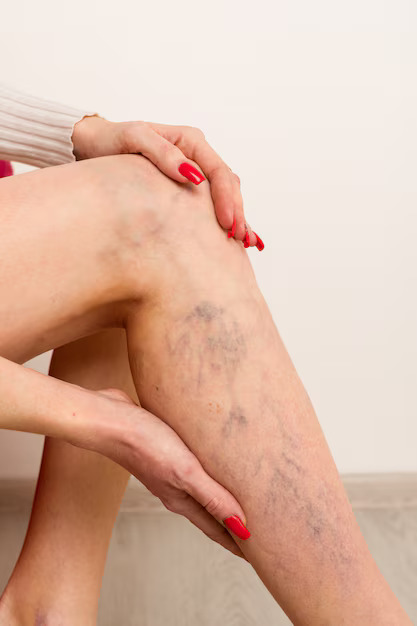
1. Chronic Venous Insufficiency (CVI)
In CVI, the valves within the leg veins are compromised or malfunctioning, allowing blood to accumulate in the lower limbs. This may lead to swelling, skin color changes, and even open wounds (venous ulcers). Compression stockings help venous return and lower venous pressure, which reduces these symptoms.. In severe cases, a spider vein specialist may recommend a combination of stockings and medical varicose vein treatment.
2. Varicose Veins
Varicose veins are swollen, tortuous ones that typically appear beneath the skin’s surface. They result from damaged valves, allowing blood to pool rather than flow normally. Compression stockings keep the discomfort, swelling, and pain of varicose veins in check and could prevent them from getting more serious over time. If left unmanaged, you may require professional varicose vein treatment from a spider vein specialist.
3. Deep Vein Thrombosis (DVT)
DVT occurs when a blood clot develops in a deep vein, most commonly in the leg. If the clot migrates to the lungs, it can be potentially life-threatening. Graduated compression stockings are usually advised for recovery from DVT and in high-risk individuals because they can prevent recurrent clotting and post-thrombotic syndrome (long-term pain and swelling following DVT). Early vein treatment and medical management are crucial in such cases.
4. Lymphedema
Lymphedema is an illness that produces swelling of the arms or legs due to obstruction of the lymph system. It can be present at birth or be caused by surgery, cancer therapy, or infection. Similar to venous in cause, compression stockings (sometimes thicker or custom-made) are essential in managing lymphedema by enhancing lymphatic drainage and decreasing swelling of the tissues. A spider vein specialist may also provide insight into related vein treatment options.
The Result: Improved Leg Health and Comfort
Whether managing a chronic condition or simply seeking to improve your leg comfort, the vein treatment support offered by compression stockings can dramatically affect how your legs feel and function. Regular use can lead to:
- Less daily fatigue
- Decreased risk of leg ulcers
- Improved healing of venous leg wounds
- Reduced pain and inflammation
- Greater mobility and energy
Types and Pressure Levels
When selecting compression stockings, selecting the proper type and pressure level for your requirements is essential. They are available in a range of lengths—ankle socks, knee-highs, thigh-highs—and three general pressure levels:
- Low pressure (less than 20 mmHg): Suitable for slight swelling or preventive use.
- Medium pressure (20-29 mmHg): It is appropriate for varicose veins or mild edema..
- High pressure (30-40 mmHg) is usually prescribed for more severe cases, such as CVI or DVT.
Although some are available over the counter, medical-strength compression stockings usually require a prescription and fitting. Your physician or spider vein specialist can advise you on how much is optimal, depending on your symptoms and diagnosis, ensuring you receive appropriate varicose vein treatment when necessary.
Who Should Use Them and When
You don’t need to be ill to enjoy compression stockings. If your work involves standing or sitting for hours on end—consider teachers, nurses, office employees, or travelers—their use can deter end-of-workday heaviness or swelling.
Here’s when to wear compression stockings:
- During work shifts that entail long periods of standing or sitting
- While flying or taking long car trips
- During pregnancy, to minimize leg swelling
- After surgery to enhance circulation and minimize clotting dangers
- When having symptoms of vein problems (fatigue, pain, or observable varicose veins)
If you’re unsure if your symptoms need medical-grade stockings, talk to your doctor or a spider vein specialist. Not everyone needs to wear them; those with peripheral arterial disease (PAD), for instance, should not wear them because there is less blood flow to the legs.
Tips for Comfort and Effectiveness
Although compression stockings can be highly beneficial, they only work if worn correctly. The following are some tips to achieve maximum comfort and results:
- Wear them in the morning. After being asleep, the legs are the least swollen and thus are easier to put stockings on.
- Use lotion or cornstarch: Apply to legs and let them dry before adding stockings to minimize friction.
- Use donning aids: Tools such as a stocking butler can aid if you experience limited hand strength or mobility.
- Make sure they fit right. If they are too constricting, they will become uncomfortable or even cause skin irritation; if they are too loose, they will not adequately support your vein treatment.
- Avoid wearing wrinkled or damaged stockings: These may cut into the skin and weaken effectiveness.
Also, always read the label—some compression stockings contain latex, so opt for latex-free ones if you are allergic.
Final Thoughts
Whether you have a diagnosed venous condition or merely wish to reduce leg discomfort during daily activities, compression stockings are a reliable and multitasking solution. They offer welcome vein treatment support, improve circulation, and can even assist in preventing more severe issues such as blood clots.
As with any health choice, getting the proper type, size, and pressure setting for your body is worthwhile. Don’t hesitate to get advice from a healthcare professional or spider vein specialist if you’re unsure about when to use compression stockings or what will be best for your case.
From flying to pregnancy, post-surgery to a typical day at the office, compression stockings provide vein treatment support you can sense, literally. Give them a try, and your legs may thank you.
To learn more about their vein care services, visit MVM Health’s website.


